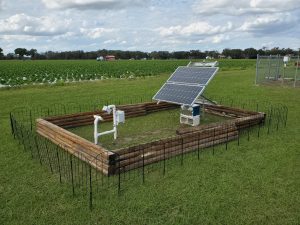Florida’s strawberry season doesn’t return until December. But University of Florida scientists work year-round to support an industry with a $500 million-a-year farm-gate value in Florida.
Among their research endeavors, UF/IFAS scientists search for ways to help growers control diseases that can damage strawberries.
Most of Florida’s 13,500 acres of strawberries grow in Hillsborough, Polk and Manatee counties. For over a decade, Florida farmers have used the UF/IFAS-designed Strawberry Advisory System (SAS) to tell them when to spray fungicides to prevent plant diseases.
SAS works with data generated by Florida Automated Weather Network stations near farms – in this case, near strawberry fields. SAS uses leaf wetness duration to help growers estimate the risk of their fruit getting infected with a fungal disease.
In newly published research, Won Suk “Daniel” Lee, a professor of agricultural and biological engineering and Natalia Peres, a professor of plant pathology, show how artificial intelligence (AI) can improve leaf wetness detection.

Continuous moisture and temperatures higher than 65 degrees, combined, give growers a sign that damaging diseases such as botrytis and anthracnose are imminent.
Lee and Peres conducted the research at the Plant Science Research and Education Center in Citra, the Gulf Coast Research and Education Center in Balm, and at farms in Dover and Plant City.
A system developed by the researchers took photos of a reference plate, which detects water more directly than the method currently used in SAS.
Scientists trained the algorithm to use the images and detect wetness. They found that AI technology improves the accuracy of wetness detection.
Nearly 96% of the time, the algorithm found moisture on the reference plate in comparison with manual observations, and a nearly 84% accuracy rate was observed when comparing with the current sensors and models in SAS.
“Ultimately, we want to replace the current wetness sensors with an imaging system because the current sensors are difficult to calibrate and not always reliable,” said Lee, corresponding author of the study. “Using the AI system, we can detect wetness and consequently forecast the disease better, so we can help growers. The implementation of this advanced detection system within SAS may improve decisions about fungicide applications and may facilitate the implementation of leaf wetness detection for disease forecasting to other crop systems.”
###
ABOUT UF/IFAS
The mission of the University of Florida Institute of Food and Agricultural Sciences (UF/IFAS) is to develop knowledge relevant to agricultural, human and natural resources and to make that knowledge available to sustain and enhance the quality of human life. With more than a dozen research facilities, 67 county Extension offices, and award-winning students and faculty in the UF College of Agricultural and Life Sciences, UF/IFAS brings science-based solutions to the state’s agricultural and natural resources industries, and all Florida residents.
 4
4
